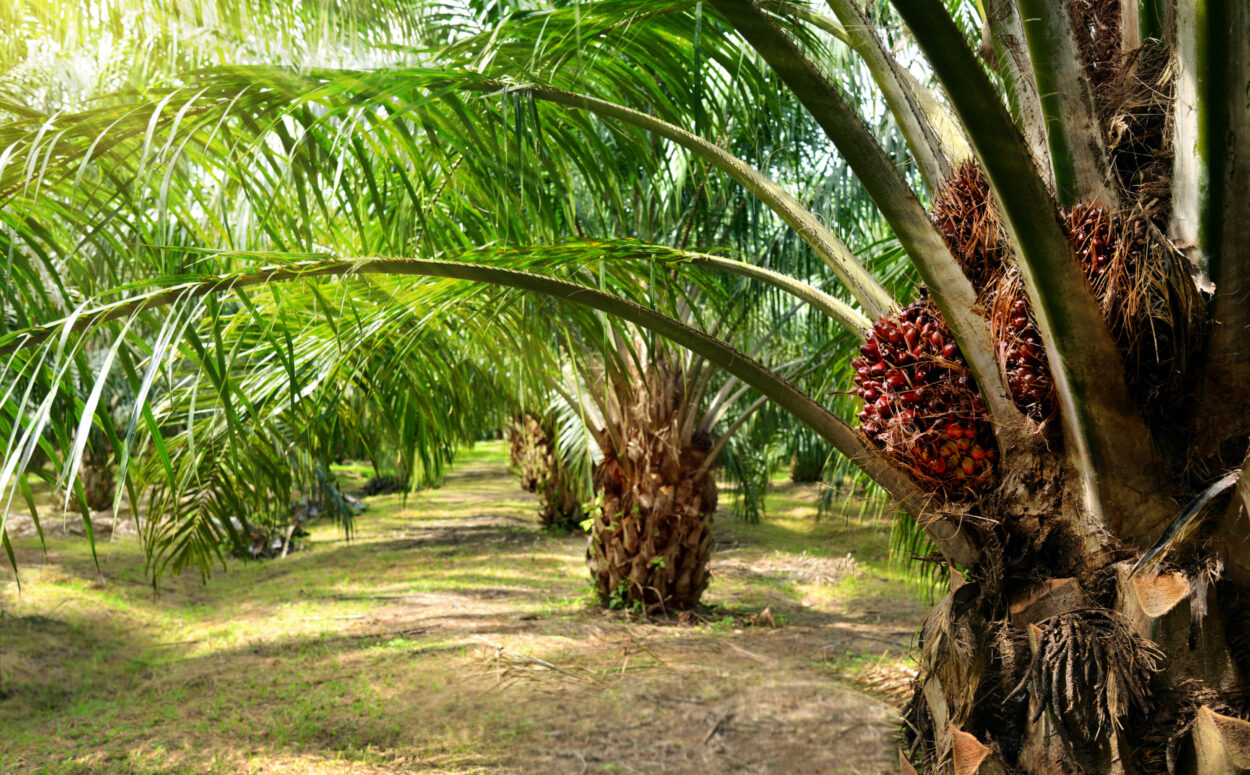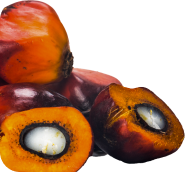
Palm oil plays a significant role in the global economy due to its widespread use across various industries.
But what is palm oil and why is it so vital to such a wide range of industries?
Palm oil is found in up to 50% of the products we find on supermarket shelves. Its popularity stems from its versatile nature and unique properties. It is semi-solid at room temperature, making it ideal for a wide range of applications and it is commonly used in everything from pizza, doughnuts and chocolate, to deodorant, soaps, shampoo, toothpaste, lipstick and mascara. Additionally, palm oil is utilized in industrial sectors for manufacturing biofuels, lubricants, and even in the production of animal feed.
Palm oil is a type of edible vegetable oil that is derived from the fruit of the oil palm tree, scientifically known as Elaeis guineensis. Oil palms are native to West Africa but is now grown extensively in tropical regions around the world, including Southeast Asia, Africa, and Latin America. Palm oil from Malaysia and Indonesia account for 85% of today’s production, but there are 42 countries which produce it.
Oil palm trees produce large bunches of fruit, similar in appearance to coconuts. Palm oil is extracted from the fruit of the oil palm tree through a series of processes that involve harvesting, sterilizing, threshing, pressing, and refining. After harvesting and sterilisation, the fruit bunches are mechanically threshed to separate the individual fruits from the bunches. The fruits consist of a fleshy outer layer (mesocarp), a hard inner shell (endocarp), and a seed (kernel) inside the shell.
The fruits are mechanically pressed to extract the palm oil, producing crude palm oil which contains oil, water, and solid particles. This is also known as red palm oil and has a distinct flavour and is used in various culinary applications.
Oil palms have a very high yield per cultivated hectare making keeping costs down and making it a critical ingredient in food, cosmetic, and personal care products, as well as for industrial applications and biofuel production.
In the food industry, palm oil serves as a versatile and indispensable ingredient and is utilized in a wide array of products, from baked goods and snacks to cooking oil and margarine. It contributes significant to global food security. Additionally, palm oil’s consistency and stability at high temperatures make it exceptionally well-suited for frying and deep-frying applications, ensuring that foods attain desirable textures and flavours while retaining their quality.
In food processing, palm oil’s ability to retain its functional properties even in various cooking processes is essential.
Palm oil possesses a range of functional properties that make it valuable for various applications in the food and non-food industries. Some of its main functional properties include:
- Palm oil has a high resistance to oxidation, meaning it doesn’t easily spoil or become rancid when exposed to air, heat, or light. This makes it suitable for long shelf-life products and high-temperature cooking processes.
- The semi-solid nature of palm oil at room temperature provides desirable textures and structures in many food products, including spreads, confections, and baked goods.
- Palm oil’s natural emulsifying properties make it useful in creating stable mixtures of ingredients that would otherwise separate, as seen in salad dressings, sauces, and other emulsified products.
- Its ability to impart a smooth and creamy texture to products contributes to the mouthfeel and overall sensory experience in items like chocolates, margarine, and ice cream.
- Palm oil has a neutral flavour profile, which allows it to take on the taste of other ingredients in food products without overpowering them.
- Its high smoke point and resistance to breakdown at high temperatures make palm oil a popular choice for deep frying, as it maintains its functional properties even under prolonged heat exposure.
- Palm oil’s ability to form different types of crystals during processing allows manufacturers to tailor its properties to specific applications, such as creating desired textures in chocolate or margarine.
- Its inherent stability and resistance to oxidation contribute to the extended shelf life of various food products.
These functional properties, along with its cost-effectiveness and high yield per hectare, contribute to palm oil’s widespread use in diverse industries.
Beyond the culinary realm, palm oil is used extensively in the cosmetics and personal care industry, being an essential component in soaps, shampoos, lotions, and makeup products.
Many of the characteristics that make it so important to the food industry make palm oil perfect for the manufacture of cosmetics and personal care products.
Some of its main functional properties in this context include:
- Palm oil’s consistency and texture make it an effective emollient, helping to moisturize and soften the skin. It forms a protective barrier on the skin’s surface, preventing moisture loss and maintaining hydration.
- Similar to its role in food, palm oil’s oxidative stability is advantageous in cosmetics and personal care products. It helps extend the shelf life of products and prevents them from becoming rancid or deteriorating over time.
- Palm oil contributes to the smooth, creamy, and easily spreadable texture of creams, lotions, and other personal care products, enhancing their application and absorption into the skin.
- In cosmetic formulations, palm oil can act as a binding agent, helping to hold ingredients together and maintain the integrity of products like solid perfumes and balms.
- In soaps and cleansers, palm oil’s ability to create stable lather and remove dirt and impurities from the skin is valuable for effective cleansing routines.
- Palm oil can serve as a carrier for various active ingredients, allowing them to be delivered to the skin effectively, enhancing the overall performance of skincare products.
- Its neutral odour and colour make palm oil versatile for blending with other ingredients without significantly altering the sensory experience or appearance of cosmetic products.
Palm oil’s natural origin aligns with the trend towards using more natural and plant-based ingredients in cosmetics and personal care, catering to consumers seeking products with fewer synthetic additives.
On top of these other uses, palm oil has industrial applications, such as biofuel production and as a lubricant in machinery.

The production of palm oil has been marred by controversies and environmental concerns. The expansion of oil palm plantations led to deforestation, loss of biodiversity, and habitat destruction for endangered species like orangutans and tigers. The clearing of land for palm oil cultivation has also contributed to greenhouse gas emissions and soil degradation. These issues have raised significant concerns about sustainability and the impact on ecosystems.
Efforts are being made to address the environmental challenges associated with palm oil production. Certification schemes like the Malaysian Sustainable Palm Oil (MSPO) and Roundtable on Sustainable Palm Oil (RSPO) have established criteria for sustainable palm oil production, encouraging responsible practices that minimize environmental harm. MSPO and RSPO certification ensures that palm oil has been sourced sustainably, meeting social, environmental, and economic standards.
While palm oil has faced criticism, it is important to recognize that it plays a crucial role in the economies of palm oil-producing nations. It provides income, employment, and economic opportunities for millions of people, particularly in developing countries. Balancing the economic benefits with sustainable practices is essential to ensure the preservation of vital ecosystems and protect the rights of local communities.